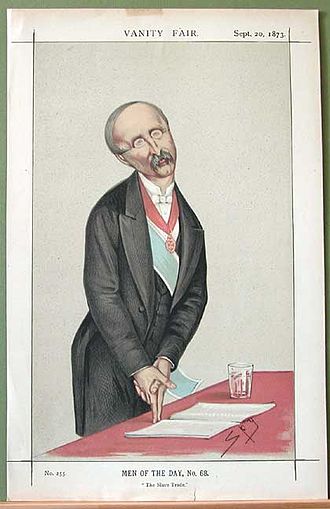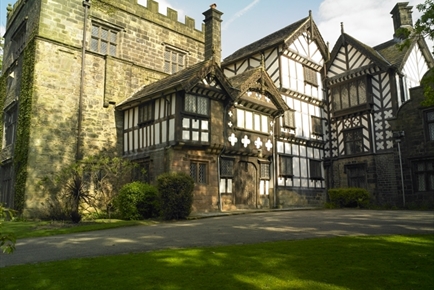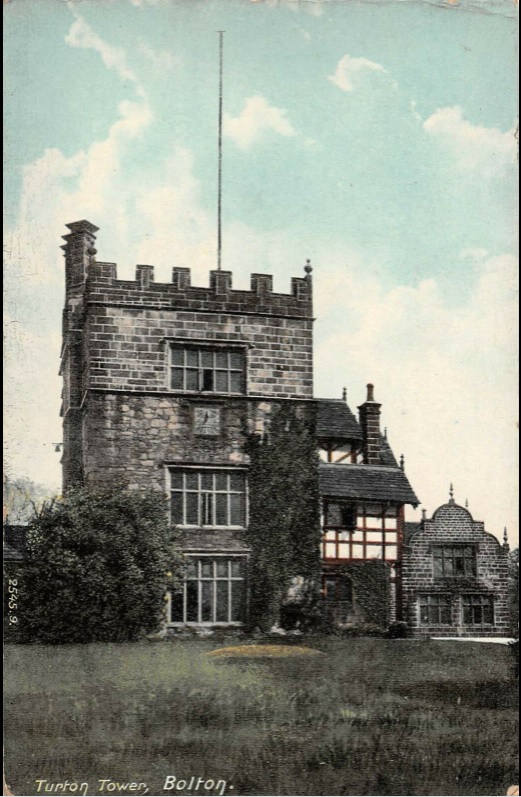Turton is named after its manor house, meaning literally Tower Town. Some sources say that there was a building built in 1101, however the earliest records of the tower state that the manor of Turton was owned from 1212 by Henry de Torboc.

The Torbocs were not local, they came from Tarbuck on Merseryside and paid feudal dues for Turton to the Barons of Manchester. In 1420 John De Torboc died, and his property was divided amongst Elizabeth, his daughter and the cousins. Elizabeth inherited Turton.
She married William Orrell and it was now that the current building started to emerge. Turton Tower is similar in construction to a Pele tower, but it is unlikely that Scottish Raiders were in mind during its construction, rather more a defence against the Torboc family. In 1533 Ralph Orrell built two sets of living accomodation at right angles to the stone tower. The Orrells owned the Tower until 1628 when the last Orrell to live there, another William, the son of John Orrell and Elizabeth Butler had borrowed £1,000 from Humphrey Cheetham¹ Debts mounted, and in 1628 Humphrey bought the Tower for £4,000. The expense of building the extensions had bankrupted the Orrell family.
Humphrey however lived mainly at Clayton Hall, although he used the Tower as a billet for Roundhead Troops in 1642. The Orrells continued to live there until 1648, when Humphrey passed the Tower to his nephew, George.
George was also a wealthy man, and he was also nearly 60. He had also like his uncle been a London Merchant. He equipped Turton with comfortable down mattresses and four poster beds. Even the servants had a degree of comfort. Tragically his son, Humphrey, died aged 23. Broken hearted he spent £170 on his funeral.
George himself died five years later in 1664 and the manor passed down through his son and grandsons and finally to Edward Cheetham who left no issue and by 1770 the Tower was being leased to Tenant farmers.
The property stayed in the Cheetham’s possession and the family were still Lords of the Manor. Ownership passed to Edward’s sister, Alice who married Adam Bland, the nephew of John of Hough End. Alice and Adam then passed the property to their daughter Mary who married Mordecai Greene, a Spanish Merchant, whose son James (1759-1814) MP for Arundel inherited after that.
James lived mainly at Raglan Tower. On his death the estate passed to his daughters, Charlotte Alice (1779-1847), Mary (1781-1846), Arabella Penelope Elizabeth (1778-1865) and Angelina Frances (1788-1846).
All the girls married well. Charlotte wed first to Richard Wilkins (1784-1817), a banker from Breconshire on St Valentine’s day 1816. He died the following January and she then married Commander Edward William Seymour RN (1791-1874) in 1821. After her death the naval man married two more times.
Mary Greene married Edward Frere (d 1847), the manager of Clydach Ironworks and the couple had 13 children. One, Sir Henry Bartle Edward Frere (1815-1884) married Catherine Arthur, the daughter of the Governor of Bombay and became his father in law’s private secretary. He rose to Chief Commissioner of Sindh where he introduced a postal system mirrored on the English version which became the basis of the Indian Post. In 1862 he was appointed Governor of Bombay before returning to England whence he was despatched to Zanzibar to put an end to slave traffic. There is an inscription across the base of the font at Manchester Cathedral to Edward and Mary Frere.
Later he accompanied the Prince of Wales to India. A mission that was so successful that Lord Beaconsfield appointed him a Baronet and Queen Victoria a Knight of the Grand Cross of the Bath. He was not as successful in his next posting as the High Commissioner of South Africa, whence he returned home in disgrace and was facing charges when he died on 29 May 1884.

Arabella married Peter Richard Hoare, who we met at Clayton Hall, and Angelina married his brother George Matthew Hoare (1779-1852) who ran the family brewery Hoare & Company, which was eventually taken over by Bass Charrington. The Hoare Toby jug trademark was carried over into the new company. George also played cricket for Surrey, appearing five times for the county.
In 1835 the Tower was purchased by James Kay (1774-1857) for £27,475 (£3.6m in 2021) who had invented a wet spinning process for flax to produce the finest cotton yarns of the time.
James was born at Edge Fold Farm, Entwistle. In 1800 he moved to Chorley, Lancashire where he improved his spinning skills and two years later married Elizabeth Helm at St John in Preston. By 1820 he had a mill on Bridge Lane in Preston and in 1825 he was at Penny Bridge Flax Mill, Preston where he started selling yarn to Northern Ireland. He moved to Pendleton in 1830 and ran into a patent infringement battle with James Marshall of Leeds, who had adopted the same process.
He retired in 1835 and moved to Turton Tower, leaving his sons to run the business, concentrating on the refurbishment of the tower which he completed in 1845.
He was succeeded by his son, James (1803-1876) who married Anne Dunn of Scarborough (1820-1880) who lived the comfortable life of Lord of the Manor at Turton, and then by James and Anne’s son, James (1852-1889) who lived for a short time at the tower, before moving to Leamington Spa around 1883, with his wife, Frances Stevens (1855-1920) when the Tower was once more put up for rental. The couple had one son, James born on the 21 February 1887. James, his father, died on 13 March 1889 and it was decided to put the entire Turton estate was put up for auction as the heir at law was under three years old. The Tower did not reach its reserve price, but there were some valuable pickings to be had:

It was bought by Anne (1829-1901) and Elizabeth Appleton (1828-1903), the daughters of Thomas Appleton (1794-1870), owner of the nearby Horrobin Mills. Thomas was a banker who became a partner in the mills in 1850 and the family began to run the mill. After Thomas’s death the mill was run by his wife, Ann and then the sisters. Quite why they bought Turton Tower is a mystery as they do not appear to have lived there much, as they were on the census for 1891 and 1901 as living at Horobin House and working the mill.
The Tower was sold again in 1903 for £3,875 (£483,000 in 2021) by Lees Knowles (1857-1928) the son of John Knowles and Elizabeth Lees of Green Bank, Oldham. His father owned Andrew Knowles & Sons Collieries who had sunk the first mine at Agecroft . Lees sat as MP for Salford West from 1886-1906, after which he retired and wrote a number of books on the life of Napoleon. He married Lady Nina Oglivy Grant (1884-1951)

Sir Lees Knowles Bt CVO 
Lady Knowles © National Portrait Gallery
Although the couple owned Turton, their main residence was Westwood in Pendlebury. They had Turton as a weekend retreat. Lees Knowles died on 7 October 1928 and once more the contents were plundered for auction the following February

There was the problem of what to do with the Hall. Manchester Council refused to buy it in 1932 and there were suggestions that it be transformed to a museum. However, there was a fear that it would go the same way as Agecroft Hall and cross the Atlantic, so Lady Knowles offered the Tower free of charge to Turton District Council on condition that it remain open to the public, as an extra protection for the Tower it was listed as an ancient monument in 1932.
The property was first used as chambers by Turton Council but in 1952 to celebrate Queen Elizabeth’s accession, Turton was one of the sites where the Royal Proclamation was read by the Chairman of the Council,
Lord Derby adding that in the County Palatine, the correct form of the Loyal Toast would be The Queen, Duke of Lancaster. It was Lord Derby who opened the Tower as a museum and it is still open to this day to visitors²
Let’s see some pictures:


Manchester Times 23 October 1891 
Lancashire Evening Post 23 January 1933 
Illustrated London News 16 February 1952 
1909 
J S Dodd
¹ Not altogether wise, considering the fate of Lawrence Brownlow at Hall’I’Th’Wood.
² Well no, virus has shut it hopefully, temporarily.
Sources:
Cotton Town – Blackburn & Darwen
The History of The County Palatine and Duchy of Lancaster III, Edward Baines : Fisher, 1836
James Kay of Turton Tower: Inventor and Flax Spinner (1774-1857), Richard Horrocks, 2020
© Allan Russell 2021